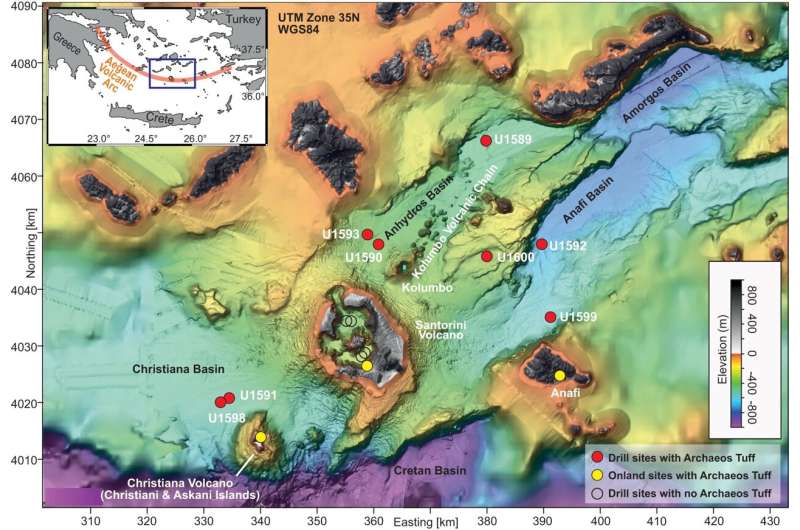This article has been reviewed according to Science X's editorial process and policies. Editors have highlighted the following attributes while ensuring the content's credibility:
fact-checked
peer-reviewed publication
trusted source
proofread
Evidence of one of the largest explosive eruptions ever recorded in the Aegean Sea

The Greek archipelago of Santorini consists of the remains of a powerful volcano. Members of the international IODP expedition "Hellenic Arc Volcanic Field" have now found evidence of one of the largest eruptions ever recorded in the southern Aegean Arc.
In their paper published today in the journal Communications Earth & Environment, they describe a newly discovered giant pumice deposit sampled from the seafloor at seven coastal sites around the island of Santorini. It shows that the Christiana-Santorini-Kolumbo volcanic field was much more explosive in the distant past than previously thought.
The volcanic field in the Greek Aegean consists of a 60-kilometer chain of more than 20 volcanoes, most of which are underwater. It is considered particularly dangerous because the volcanoes there have a history of eruptions, some of which have been highly explosive.
"For example, the Late Bronze Age eruption of Santorini around 3,600 years ago probably triggered the downfall of the Minoan civilization on Crete—an important event for both volcanology and archaeology," says Dr Steffen Kutterolf, a volcanologist at the GEOMAR Helmholtz Centre for Ocean Research in Kiel.
Together with Dr Timothy Druitt from the University of Clermont-Auvergne, he led the expedition to Santorini. The international team of scientists discovered a new deposit around the island, indicating a much larger submarine eruption around 520,000 years ago.
Dr Kutterolf says, "The newly discovered tuff deposit has a volume of more than 90 cubic kilometers and is up to 150 meters thick. This makes it six times larger than the pyroclastic flow deposits of the Minoan eruption and ten times larger than those of the Hunga Tonga-Hunga Ha'apai volcanic eruption of 22 January 2022."
Pyroclastic flows are streams of hot ash, rock, and gas that, in the case of the newly mapped Santorini event, originated from a submarine volcano at the time and were transformed with the water into turbid flows and mud. These flows transported large quantities of volcanic material up to 70 kilometers into the surrounding sea basins. Layers of rock from this eruption have also been found on three neighboring islands.
Various methods were used to decipher the eruption. Dr. Kutterolf says, "The first dating and estimation of the water depth at which the eruption took place were possible directly on board thanks to micropalaeontology." Microfossils (foraminifera), whose geological age and preferred water depths are known, were found directly above and below the pumice deposits.
Physical parameters such as density and porosity were also determined on board. The chemical composition of the drilled samples was then analyzed using GEOMAR's electron microprobe, a special scanning electron microscope.
"The sample is bombarded with an electron beam with a diameter of 0.01 millimeters. This provides information on how many chemical elements, such as silicon, iron or magnesium, are contained in the quenched magma." This allowed the deposits to be precisely linked to their locations on the seafloor, which in turn helped to determine their spread and thickness, and ultimately the size of the eruption, using seismic images of the seafloor.
Despite this explosive history, the researchers agree that it is very unlikely that the volcanic field will experience another eruption of this magnitude in the near future. "But knowing the past is also an essential building block for predicting the future," says Dr Kutterolf.
More information: Tim Druitt et al, Giant offshore pumice deposit records a shallow submarine explosive eruption of ancestral Santorini, Communications Earth & Environment (2024). DOI: 10.1038/s43247-023-01171-z
Journal information: Communications Earth & Environment
Provided by Helmholtz Association of German Research Centres




















